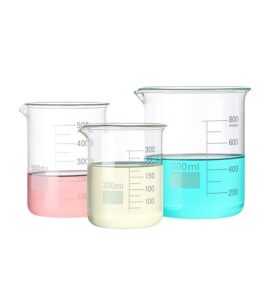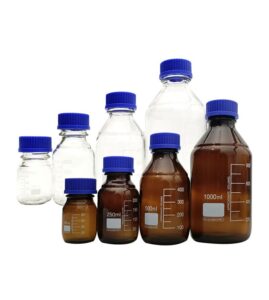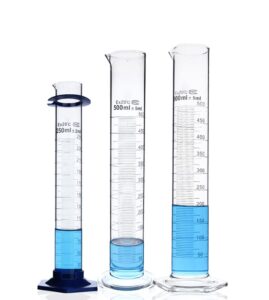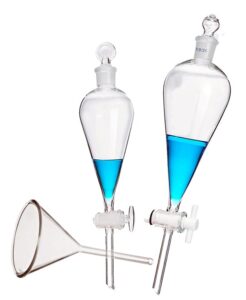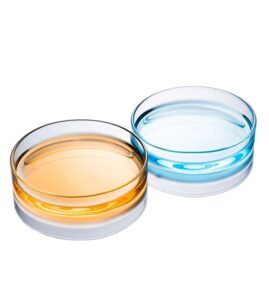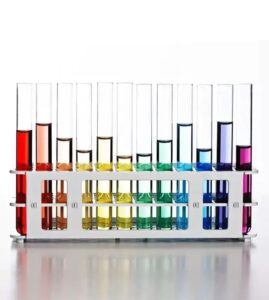Are you puzzled about the correct way to utilize multi-neck flasks? Or perhaps uncertain about the practices you should follow and avoid while handling these complex-looking glassware items? Are you searching for a step-by-step guide to streamline your laboratory operations involving multi-neck flasks?
Look no further! This blog post aims to offer a comprehensive guide to using multi-neck flasks, brimming with practical examples. Whether you’re a chemistry student initiating lab work or a seasoned scientist needing to refresh your skills, this guide will provide you with the knowledge needed to handle multi-neck flasks confidently.
Let’s dive into the captivating world of multi-neck flasks!
Understanding Multi-Neck Flasks
Multi-neck flasks come in various configurations, with two-neck, three-neck, and four-neck designs being the most common,and are available in different capacities. The central neck typically includes a standard taper outer joint, while the angled side necks have smaller ground glass joints. The choice of flask depends on the complexity of your experiment and the number of additives required. The central neck is traditionally for stirring, and the additional necks can be used for adding reagents, temperature monitoring, or gas release.
Applications of Multi-neck Flasks in Various Fields
Multi-neck flasks, because of their specialized design and non-reactive nature, find utility in several applications. Primarily made of borosilicate glass, these flasks can withstand high heat and resist chemical reactions, making them suitable for various purposes.
In chemical laboratories, multi-neck flasks enable scientists to perform complex reactions involving multiple reagents. The additional necks allow simultaneous addition of substances or the extraction of gases or vapors, facilitating intricate chemical procedures.
In pharmaceutical industries, multi-neck flasks aid in synthesizing various drugs by allowing multiple reactions to occur concurrently in a controlled environment.
In the field of material science, these flasks are useful for the development of polymers and other complex materials through multi-step synthetic processes.
Despite their advanced design, mastering the use of multi-neck flasks is not an insurmountable task. With proper understanding and careful handling, you can make the most of these unique pieces of laboratory equipment.
Mastering the Basics: A Step-by-Step Guide to Using Multi-neck Flasks
After understanding the versatile applications of multi-neck flasks, it’s time to explore their practical usage. From preparing the flask for an experiment to managing a complex reaction and cleaning up afterward, these steps provide an exhaustive guide to help you navigate the process.
How to Use a Multi-Neck Flask: A Detailed Walkthrough
Step 1: Setup and Safety Precautions
While handling multi-neck flasks, safety is a primary concern. Ensure the flask is clean and free of cracks before use. If heating is involved in your experiment, a heat-resistant mat should be placed underneath the flask to protect the work surface. Handle it carefully to avoid dropping, as the multiple necks can make it a bit unwieldy.
Step 2: Adding Reagents
Using appropriate glassware, carefully add the required reagents into the respective necks of the flask. Always remember to add reagents in a manner that avoids direct contact with your skin and eyes. Add the substances carefully into the appropriate necks. Never fill the flask to the brim; leave some space to allow for possible reaction expansion. Always be vigilant about the reaction’s progress.
Step 3: Heating and Stirring
When heating a multi-neck flask, it’s crucial to distribute the heat evenly to prevent cracking or localized overheating. A heating mantle or oil bath can help achieve this. If your procedure calls for stirring, insert a magnetic stirring bar into the flask before adding any chemicals.
Step 4: Monitoring the Reaction
For a reaction, the flask typically needs to be clamped securely at the neck. The setup often includes a stir bar placed inside the flask for mixing the reaction. Additional equipment, like thermometers, condensers, or dropping funnels, can be inserted into the other necks as required. Generally, use one of the additional necks to insert a thermometer, allowing you to keep a close eye on the reaction temperature. Adjust the heat source as needed to maintain the desired temperature.
Step 5: Cleanup and Maintenance
After the completion of your experiment, let the multi-neck flask cool down before cleaning. Depending on the chemicals used, you may need to rinse the flask with distilled water or a specific cleaning solution. Be sure to clean all the necks and joints thoroughly.
Step 6: Storage
Dry the multi-neck flask completely before storage to prevent the growth of bacteria or fungi. Store the flask in a designated safe space to avoid accidental falls or contact with other chemicals.
Hands-On Example: Conducting a Reflux Reaction in a Multi-neck Flask
To illustrate the usage of multi-neck flasks, let’s go through a basic experiment: conducting a reflux reaction. This will involve setting up the flask, adding reagents, setting up a condenser, and heating the flask to maintain a reflux.
Materials needed:
Multi-neck Flask
Reagents (as per the reaction you’re performing)
Condenser
Bunsen burner or hot plate
Stirring rod
Procedure:
Setting Up the Multi-neck Flask: Securely clamp your multi-neck flask in place. The flask should be stable and at a height that allows for easy manipulation of its contents. Insert a stir bar if stirring is needed for your reaction.
Adding Reagents: Add your reagents into the flask through the appropriate neck. Do this carefully to prevent any spills or splashes.
Setting Up a Reflux: Fit a condenser into one of the necks of the flask. Connect it to a water source to keep it cool. The condenser will allow the heated vapors to condense and fall back into the flask, maintaining a constant reaction environment.
Heating the Flask: With a Bunsen burner or hot plate, start heating your flask. Adjust the heat as necessary to maintain a gentle reflux. Keep an eye on the reaction to prevent any overflow or rapid reactions.
Observing the Reaction: Allow the reaction to proceed as per your experimental protocol. Observe any changes or progression in the reaction.
Cleaning Up: Once your experiment is complete, allow the flask to cool down before you attempt to clean it. Depending on the chemicals used, you may need to use specific cleaning agents to ensure the flask is thoroughly cleaned.
Bonus Tips: Troubleshooting Common Problems
While working with multi-neck flasks, you might encounter some challenges. Here are some common issues and suggestions on how to resolve them:
- Difficulty in Monitoring Reaction: The multiple necks may sometimes obstruct the view of the reaction. Use a mirror or a camera for better monitoring if needed.
- Breakage of Flask: These flasks are more susceptible to breakage due to their design. Handle them with care, and always check for any damage before use.
- Difficulty in Cleaning: Residues in multi-neck flasks can be tough to clean due to the flask’s shape. Use a flask brush and appropriate cleaning agents to ensure a thorough cleaning.
Practical Tips and Troubleshooting
Despite your best efforts, you may encounter challenges when working with multi-neck flasks. Here are some common issues and how to address them:
- Difficulty in Heating: If you’re having trouble evenly heating the flask, try using a heating mantle or an oil bath. These tools can help distribute heat evenly, preventing hotspots and potential flask breakage.
- Joint Stuck: Joints can occasionally become stuck. To prevent this, use a small amount of vacuum grease on the joint before assembling. If a joint becomes stuck, gentle heat can help loosen it.
- Flask Contamination: Always use clean, dry flasks for each new experiment. Rinse and clean them properly after each use to avoid cross-contamination.
Extending Your Lab Toolkit: Essential Equipment for Working with Multi-neck Flasks
In order to get the most out of your multi-neck flask, you’ll also need to become familiar with the tools that are used alongside it. This equipment – including clamps, condensers, stir bars, dropping funnels, and flask brushes – enhances the efficiency and safety of your work with multi-neck flasks.
- Clamps: Clamps are used to securely hold your flask in place during an experiment.
- Condensers: A condenser can be inserted into one of the necks for reflux or distillation procedures.
- Stir Bars: Stir bars are magnetic bars placed inside the flask for stirring the contents during a reaction.
- Dropping Funnels: These can be fitted to one of the necks for the gradual addition of a reagent to the reaction.
- Flask Brushes: A flask brush is necessary for cleaning the interior of the flask after use.
Advanced Techniques: Enhancing Your Multi-Neck Flask Skills
Once you are comfortable with the basics, consider exploring more advanced techniques:
- Distillation: Multi-neck flasks are great for distillation processes, especially where multiple fractions need to be collected. The extra necks can accommodate different outlets, each leading to a separate collection flask.
- Gas Entrapment: The extra necks in these flasks can be used for gas entrapment studies. You can bubble a gas through one of the necks while the reaction proceeds in the flask, enabling you to study the effects of various gases on the reaction.
- Reflux: Multi-neck flasks are also excellent for reflux procedures where the vapor needs to be condensed and returned to the flask. A condenser can be fitted into one of the necks, allowing for effective reflux.
Essential Equipment for Working with Multi-Neck Flasks
In addition to the multi-neck flask itself, there are other tools that enhance the safety, efficiency, and precision of your lab work:
- Heating Mantles: These can provide even heating for your multi-neck flasks and are especially useful when working with flammable substances, as they eliminate the need for an open flame.
- Clamps and Stands: These are crucial for securely holding your multi-neck flasks, especially when they’re being heated or are full of reagents.
- Thermometers: These are essential for closely monitoring the temperature within your flask during reactions.
- Stirring Bars and Stir Plates: These allow for continuous and consistent stirring of your reactions without the need for manual intervention.
- Ground Glass Stoppers: These are used to close off any unused necks during a reaction, preventing the escape of gases or the entry of contaminants.
- Condensers: These are essential for reflux operations, enabling the condensation and return of evaporated solvent back to the flask.
Additional Tips and Insights
The art of utilizing multi-neck flasks in your laboratory work is an advanced skill that can significantly enhance your research and experimentation capabilities. These adaptable flasks enable complex and intricate reactions, and mastering their use is an important milestone in your journey as a scientist. Here are some additional tips and insights that might come in handy as you delve deeper into the world of multi-neck flasks.
- Care with Heating: Since multi-neck flasks are often made of glass, they are susceptible to cracking due to rapid temperature changes. To avoid this, heat should be applied slowly and evenly, and the flask should be allowed to cool down gradually after the reaction is complete.
- Understanding Necks’ Usage: The different necks of a multi-neck flask can serve different purposes simultaneously, such as adding reagents, stirring, or introducing an inert gas atmosphere. However, it is crucial to plan your procedure carefully and understand what each neck is being used for.
- Attention to Reaction Progress: Just as with any other reaction vessel, careful monitoring of the reaction progress in a multi-neck flask is essential. If the reaction seems to be getting out of control (e.g., it’s producing too much heat, bubbling vigorously, or producing an unexpected color change), you should be prepared to stop the heat and safely neutralize the reaction if necessary.
- Use of Safety Equipment: As always, safety should be your number one priority. Always use appropriate safety gear, including gloves, safety glasses, and a lab coat when working with multi-neck flasks, especially when handling potentially hazardous reagents or when the reaction is under heating.
- Proper Maintenance: To maintain the longevity and integrity of your multi-neck flasks, they should be cleaned and stored properly after each use. This includes thoroughly rinsing the flask to remove any residual chemicals, cleaning it with an appropriate cleaning agent, and storing it in a safe location where it won’t be knocked over or exposed to extreme temperatures.
In the end, the most important aspect of mastering the use of multi-neck flasks is practice and experience. Each time you set up a reaction in a multi-neck flask, you will become more familiar with its handling and more proficient in your technique. Over time, you’ll develop the ability to conduct more complex procedures and reactions, opening up new avenues of research and experimentation. Happy experimenting!


